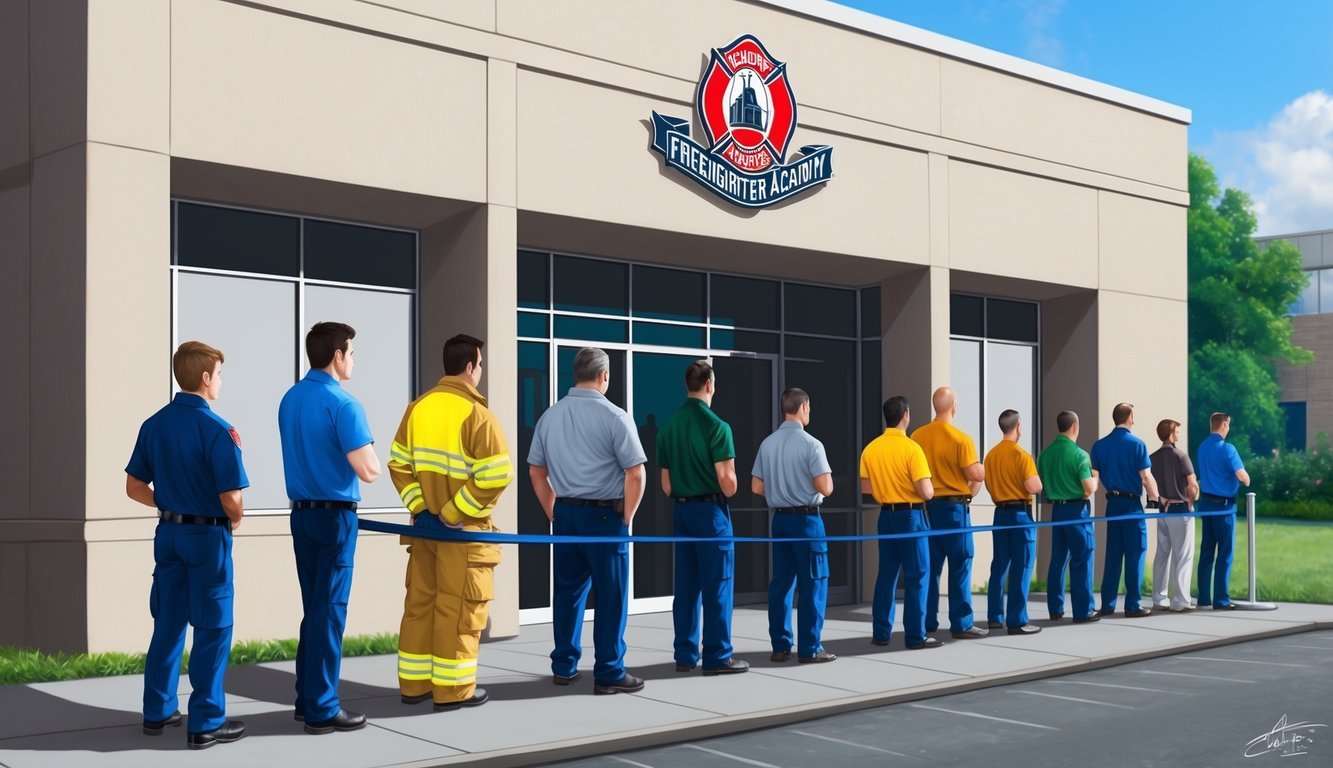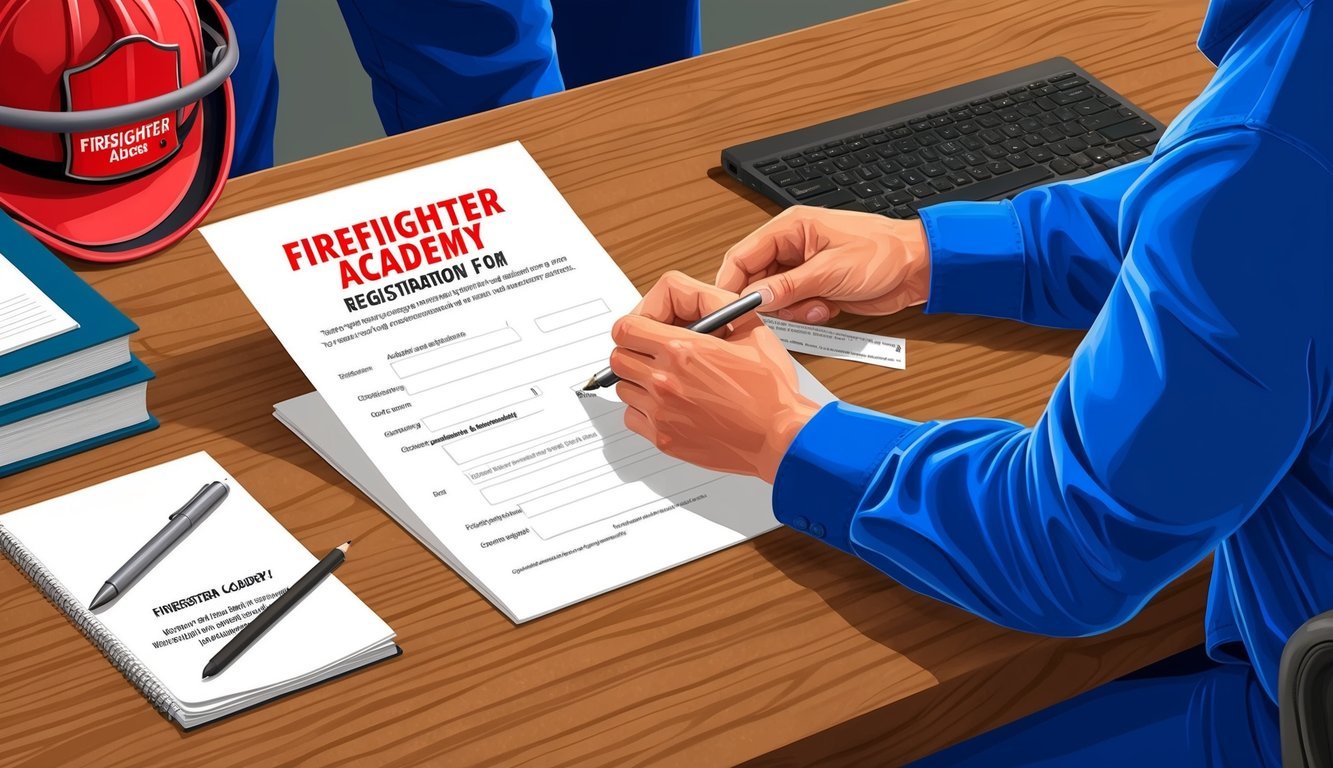If you’re dreaming of becoming a firefighter, you’re in for an exhilarating ride! It’s a path filled with hard work, dedication, and a lot of training.
Your journey kicks off by enrolling in a firefighter academy. Just a heads-up—you generally need to be between 18 and 45 years old with a high school diploma or something equivalent.

When it comes to signing up for a firefighter academy, the process can vary depending on where you live and the specific program you’re looking at.
Many academies even let you apply online right from their website.
Some programs are first-come, first-served as soon as new courses pop up, while others have set application windows.
You can expect fire academy training to last anywhere from 10 to 24 weeks, adding up to about 600 hours of hard work.
During this time, you’ll get into shape, learn firefighting techniques, and even pick up some emergency medical skills.
It’s definitely challenging, but it’s all worth it when you’re gearing up for a career in firefighting.
Key Takeaways
- Most fire academies have age and education requirements for enrollment.
- Training usually lasts between 10 to 24 weeks and covers essential firefighting skills.
- You can often apply online for fire academy programs.
Getting into the Academy
Okay, let’s talk about what it takes to get into a firefighter academy.
It’s like prepping for a big game—you’re going to need to know the rules, fill out forms, and choose the right classes.
First things first, do a little research on the specific requirements of the firefighter academy you’re eyeing.
They can differ quite a bit depending on your location.
After that, gather up your documents—like ID and medical records—so you can complete your application.
And if you’re also curious about how to join a police academy, the process is quite similar, featuring physical exams and background checks.
Understanding the Requirements
To join a firefighter academy, you’re gonna want to be in peak physical shape.
Most places expect you to be at least 18 years old and have a high school diploma.
You’ll also need a valid driver’s license—because you don’t want to be late to your calls!
Many academies adhere to NFPA 1001 standards, which ensures you learn all those crucial skills every firefighter should have under their belt.
Some academies might also require you to hold an EMT certification.
Before you hit that apply button, make sure you can conquer a physical test.
You’ll likely be tasked with running, lifting, and scaling ladders.
It’s wise to start working on your fitness long before you apply.
Navigating the Application Process
Alright, you’re ready to apply! Many fire departments have their own training academies.
There’s also the opportunity to check out the National Fire Academy (NFA).
Here’s what you’ll typically need to do:
- Fill out an application form
- Pass a background check
- Take a written test
- Complete a physical abilities test
Some academies might even throw in an interview.
Be prepared to articulate why you wanna be a firefighter—what’s that spark that ignited your passion?
Don’t be discouraged if you don’t get in on your first try.
It’s pretty common for people to apply more than once before they are accepted!
Choosing Your Courses
Once you’re accepted, it’s time to select your courses.
The NFA offers a variety of options, including on-campus, online, or self-study classes.
Popular courses at the NFA often include:
- Fire Investigation
- Emergency Medical Services
- Hazardous Materials
Make sure to check for openings in your desired courses before applying—you don’t want to miss out because they filled up too fast.
If a class is full, you might be able to take it online instead.
Remember, firefighting is always evolving, and you’ll be picking up new skills even after you graduate from the academy.
After Enrollment

You’ve made it into firefighter academy—big congrats! Now, it’s time to buckle down on your training and education.
You’ll find plenty of opportunities to boost your career and measure your progress along the way.
Earning College Credit
Many fire academies give you a chance to earn college credit while you train.
This could really give your career a smooth boost! The NFA courses can often count toward college credit, which was a game-changer for many folks I know.
It’s a smart move to work towards a degree while getting hands-on experience.
Some academies even partner with local colleges, allowing students to earn credits that can transfer over to degree programs.
Don’t hesitate to ask your academy about these cool options.
And here’s a little bonus—you might also snag Continuing Education Units (CEUs) for your training, which can help you keep your certifications current.
Tracking Your Progress
Keeping track of your training is super important.
Most academies offer tools to log your classes and acquired skills.
The NFA awards certificates when you complete courses, proving what you’ve learned.
You’ll likely walk away with an NFA transcript too, showcasing all the courses you’ve taken.
This will come in handy for job applications and promotions down the line.
Many academies integrate online learning systems, making it easy to see your grades, completed courses, and upcoming classes.
It’s a breeze to stay organized and on top of your training.
And don’t forget to save all your certificates and transcripts.
They’re your badges of honor, proof of your hard work and skills.
Frequently Asked Questions

Thinking about joining a Fire Academy? Let’s tackle some common questions that might be buzzing in your mind.
What are the steps to apply for a local Firefighter Academy?
First up, you’ll want to fill out an online application.
For the best experience, use a desktop.
Aim to submit your application as soon as the class schedule is released!
You usually have about 14 days after the course wraps up to apply.
Check in with your local fire department for any specific deadlines or requirements.
What are the prerequisites for enrolling in a Firefighter Academy?
Prerequisites can vary quite a bit between academies.
Generally, you’ll need to be at least 18 years old and have a high school diploma or GED.
Be ready to show a valid driver’s license and possibly CPR certification.
Most places also prefer a clean criminal record and a solid level of physical fitness.
How can I find a Fire Academy close to my location?
To find a nearby Fire Academy, start with your local fire department—they often have all the scoop on training programs in your area.
Another approach is to search online for fire academies in your state or county.
Community colleges might also have firefighter training programs worth considering.
What’s the usual duration of a Fire Academy program?
Fire Academy programs typically run for about 10 to 24 weeks.
Most times, you’ll be looking at around 600 hours of training, which includes everything from classroom time to physical training and hands-on firefighting practice.
The exact length can depend on the academy and the type of program.
Can I complete Firefighter training online, and if so, how?
While some aspects of firefighter training can be done online, hands-on skills training needs to happen in person.
Check out FireRescue1 Academy for online courses geared toward fire safety officials.
A mix of online study and in-person training is common across many programs.
What’s the cost range for attending a Fire Academy?
The costs of attending a Fire Academy can swing quite a bit, ranging from a few thousand dollars to over $20,000.
Public academies run by fire departments are usually on the cheaper side, while private academies or programs at colleges might hit the higher end of the scale.
Always check with local academies for precise pricing information.

